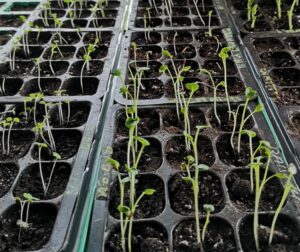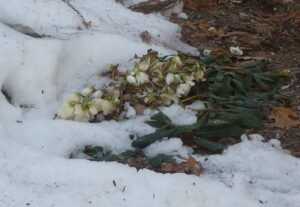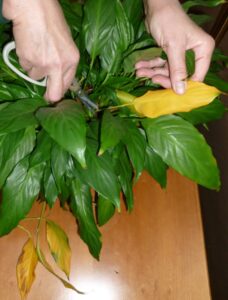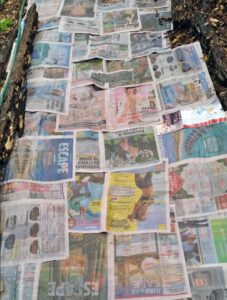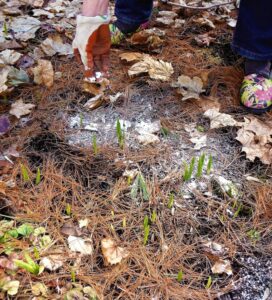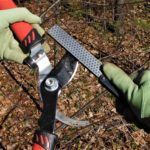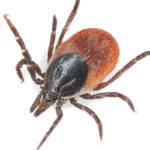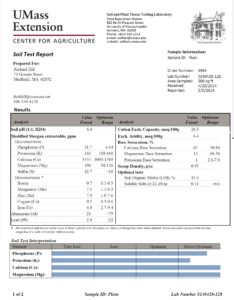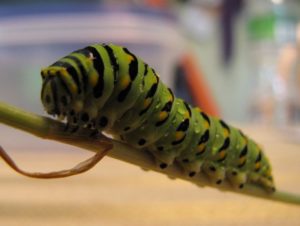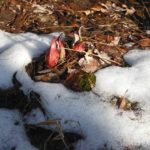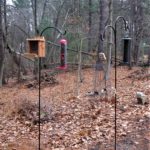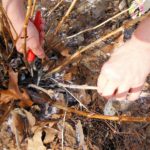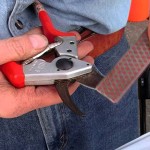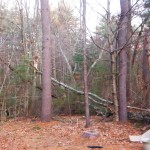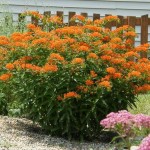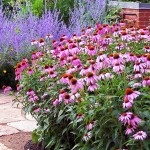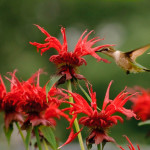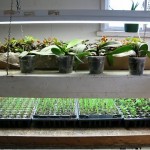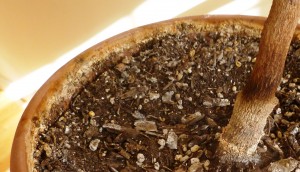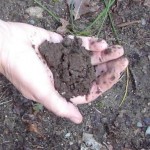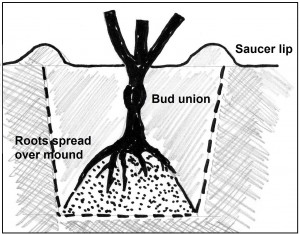Horticultural Hints – March
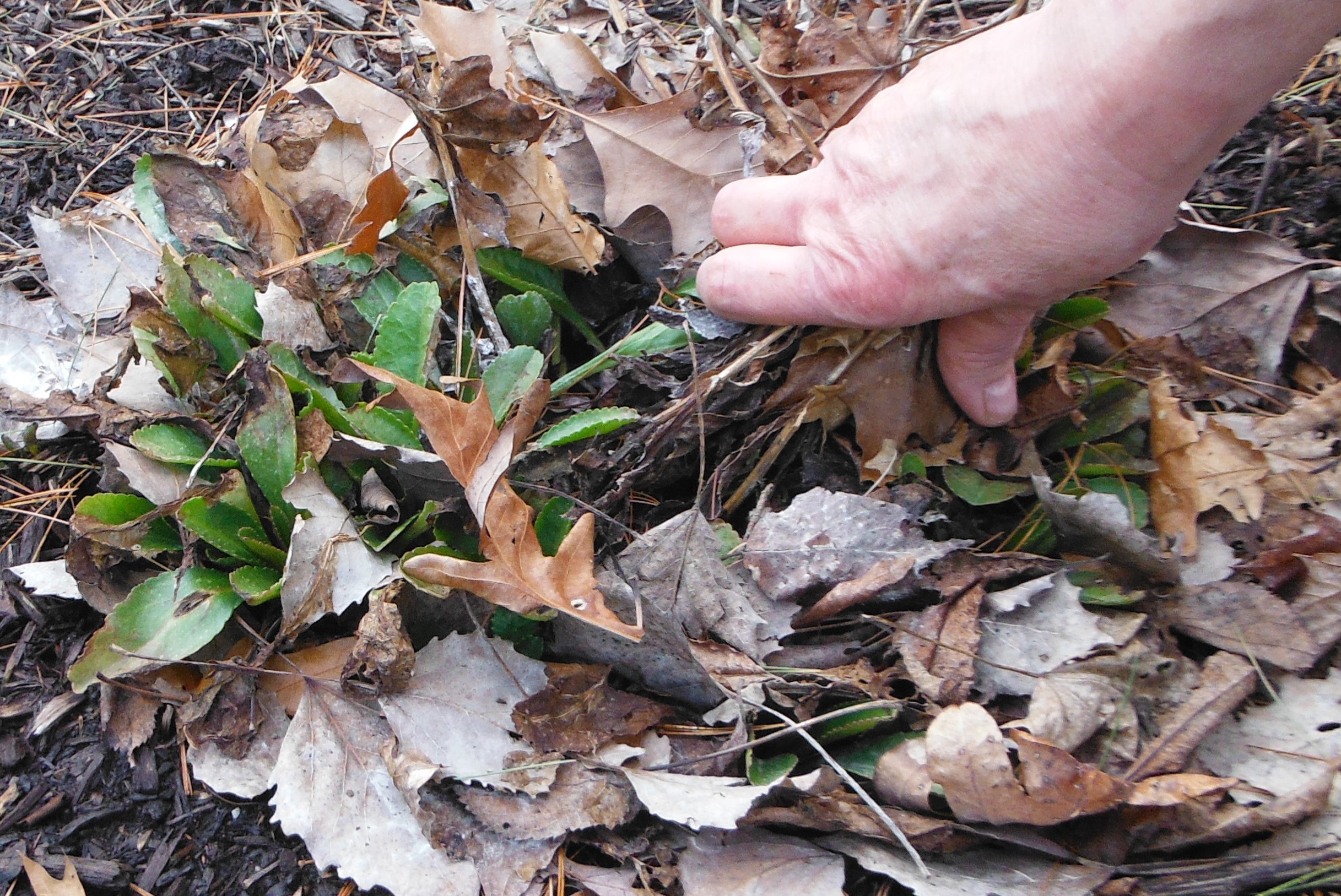 Do not be too hasty in removing protective mulches or covers from roses, perennials, bulb beds and so forth. Winter storms and snow can still make a re-appearance.
Do not be too hasty in removing protective mulches or covers from roses, perennials, bulb beds and so forth. Winter storms and snow can still make a re-appearance.
Last call to order seeds and clean garden tools. You will already find seed houses out of some varieties. Tools that haven’t been cleaned, sharpened and repaired will make your work in the garden harder when you begin cleaning up from winter and prepare for spring planting. Lawn mowers and rototillers should be sent out now for a tune-up before the warm weather creates a rush at the repair shop.
When the lawn has dried enough to allow you to walk on it without creating impressions in the soil, rake it to remove dead and matted grass. Thin or bare spots in the lawn can be ‘frost seeded’ by simply spreading seed over the area. The freeze and thaw cycle, or even a late snow, will ensure that the seed is worked into the lawn. Spring is not a good season for a complete lawn makeover. Weed seeds that are present will more quickly take advantage of the conditions you create for the grass.
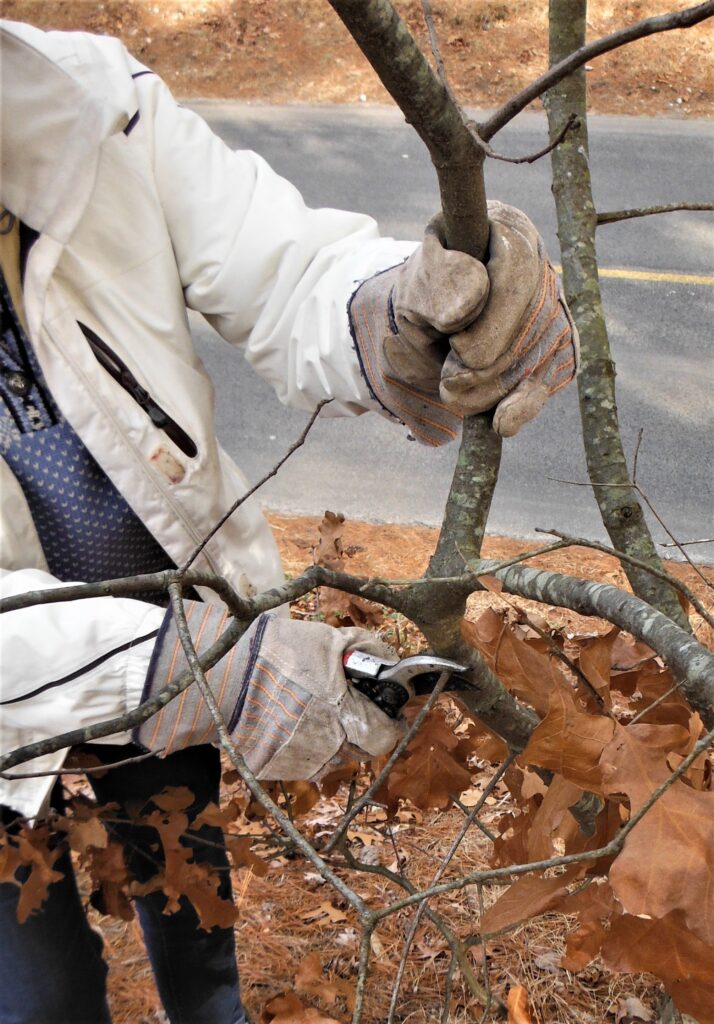 Pruning time, but keep your pruners away from spring blooming plants. Go into the yard and remove any damaged branches on your trees and shrubs, prune late bloomers and those that don’t bloom for shape or size while the ground remains frozen. Prune most fruit trees and shrubs, blueberries and raspberries, now. Prune back any broken branches such as rose canes and vines that were left in place last fall. They need to go so the new growth can emerge.
Pruning time, but keep your pruners away from spring blooming plants. Go into the yard and remove any damaged branches on your trees and shrubs, prune late bloomers and those that don’t bloom for shape or size while the ground remains frozen. Prune most fruit trees and shrubs, blueberries and raspberries, now. Prune back any broken branches such as rose canes and vines that were left in place last fall. They need to go so the new growth can emerge.
In the vegetable garden. Do not start working soil before the winter moisture has dried or you will ruin the soil structure. Soil is ready to be worked when it crumbles when lightly squeezed in your hand.
Clean off cold frames and hotbeds and plant them now for early crops of spinach, kale, oriental greens like bok choy, and even peas. Some varieties of peas only grow to 18 inches and will do well in a cold frame, but it may be well after St Patrick’s Day before most of us get to plant peas this year. If you haven’t ordered your vegetable and flower seeds yet, do so immediately!
While the ground is still too cold to plant most things, it’s a good time to start seeds for this year’s garden. Under grow lights you can start onions, leeks, broccoli, and cauliflower now. For your flower garden, sow seeds of geraniums, petunias, snap dragons, begonia and coleus.
Planting summer flowers and bulbs. Get as head start on tender bulbs such as begonias, cannas, colacassia (elephant’s ear), dahlia and ranunculus. Started indoors in pots. they will be larger and bloom sooner after you put them outdoors once the weather has warmed sufficiently. Check the details for individual bulbs or corms, but most can be potted now in a lightweight, well drained potting mix. When the shoots appear, move them to a site where they get several hours of sunlight a day. As the temperatures rise, increase their sunlight exposure. Once the danger of frost is past, you will have plants on their way for your summer gardens or containers.
The ground may still be frozen, but planning your 2021 garden should be well underway. If your flower and vegetable seed order hasn’t been sent in, do it quickly. When they arrive, check seeds packets for advice on when to start each variety of seed. Starting them too early often leads to leggy or weak seedlings from having spent too long waiting indoors for warm weather to arrive. Use only sterile soil mixes to prevent damping off (fungal growth) on seedlings.
Envision next spring as you enjoy this one. Take a walk around your yard (staying off muddy ground) and enjoy the earliest flowers. Witch hazels (Hamamelis) are in bloom and cornelian dogwood (Cornus mas) are close behind. As snow cover gives way, look for hellebore blooms to put in an appearance along with the early bulbs such as snowdrops, Siberian squills and crocus. Don’t have any planted bulbs or early shrubs? Make notes on where they would look great (and where the snow melts more quickly), take photos of the best sites, and tag them so you don’t forget where to plant this autumn for next spring.
With more sunlight coming in the windows, your houseplants should be waking up. If you haven’t already, begin fertilizing lightly to feed the new growth. Don’t forget to keep the humidity up with misting or pebble trays—our homes remain very dry as long as the heating systems are on. Trim off any ragged or weary leaves – the plant will look better immediately and the new leaves will have room and light to grow.
There is more to gardening than plants. Use these cold and wet days to spruce up outdoor furniture—sand and refinish wood, remove rust and repaint metal. If your refurbishing work cries out for new fabric for the cushions, you’ll be glad you did it when you are ready to use them in the warm months.
Do you have early-season weeds popping up in your vegetable or flower garden? Spread newspapers or cardboard (not shiny or glossy paper!) over your bed now and weigh down with rocks. Remove the material when the soil has warmed enough to start planting, and you will have eliminated weeding those beds from your spring chores.
Give your houseplants room to grow. Not every day is good for outdoor gardening, so now is a good time to do some work indoors. Transplant houseplants in March to prepare them for a spring growth spurt. Always use a clean pot. Scrub salt and dirt from old pots and rinse out new pots before using. Remember to never put a plant into a pot more than one size larger than its current pot. Otherwise, it will disappoint you by spending more energy growing underground than up top. Prune dead or circling roots to encourage new ones to form. Always remove dead leaves, old flowers, and any salt that have built up around the stem of the plant or on top of the soil. And don’t forget to wash the leaves to remove dust from them. Finally, water thoroughly but do not let the pot sit in the water that has drained through.
When your spring bulbs appear, sprinkle a small amount of organic fertilizer and lime around – not on – the new greens. This will wash into the soil with spring rains and help the bulb get ready for next year’s flowers. This year’s flower is already in the bulb, waiting for the right weather to appear. An application of organic mulch around the foliage will keep weeds down around the bulbs and add organic to the soil later. If you planted your bulbs among perennials, (good for hiding the bulb foliage as it dies) do not mulch until the perennials are up.
An overall note: The lack of snow this winter in southern New England was not good news for our plants. Snow acts as insulation against the cold and sudden temperature changes. Moreover, the 30-day forecast for March continues the trend for above-average temperatures. Do not be surprised if you lose some plants that are borderline for your zone—and maybe even a few that aren’t.
Use a nasty day to sharpen hand tools such as pruners, trowels and hoes. Clean, sharp tools will make your work easier and, in the case of pruners, ensure no damage to the shrubs you use them on. Send your mower out to be tuned and sharpened before the shops get busy.
When the soil in your yard is dry enough not to leave footprints when walked on, collect the sticks, branches and debris from your lawn. Then, give it a good raking with a steel-tined rake to remove dead grass, the dead leaves, and any other debris that has accumulated since the end of autumn.
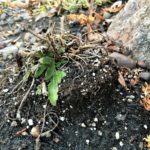
Check your garden for plants – especially perennials – that may have been heaved out of the ground by repeated freezes and thaws
While taking care of outdoor chores, look around your yard looking for plants that have been heaved out of the ground by frost. If it is possible, push them back into the soil. If the soil is still frozen and you cannot replant, cover the roots with four or more inches of fresh soil or mulch. But, make certain you make a note to yourself to plant it properly when the weather allows!
Cut back dead plant material that you had left standing over the winter. Remove the old stalks and leaves so the new growth will have a clear path for growing, blooming and brightening your yard come spring.
Bring spring indoors. Force branches of witch hazel (which smell wonderful) forsythia, quince, cornus mas, fruit trees and magnolia. Remember when cutting the branches you are actually pruning, so keep the plant’s overall shape in mind. Once indoors, make a fresh cut and place the branches in three inches of warm water with a preservative. Change the water regularly to prevent the growth of bacteria which can inhibit blooming. Once the flowers pop, bring them into a bright room and enjoy your early spring.
You can start planting summer flowers and bulbs—in pots! Get a head start on tender bulbs such as begonias, cannas, colacassia (elephant’s ear), dahlia and ranunculus. Started indoors in pots. they will be larger and bloom sooner when you put them outdoors after the weather has warmed sufficiently. Check the planting details for individual bulbs or corms, but most can be potted now in a lightweight, well drained potting mix. When the shoots appear, move them to a site where they get several hours of sunlight a day. As the temperatures increase, increase their sunlight exposure.
Beware of ticks. This is a hint that normally doesn’t show up until April at the earliest, but this is an unusual year. The lack of snow and persistent above-freezing temperatures this winter mean disease-bearing ticks are active and looking for a blood meal. Spray your clothing with a DEET-type insecticide and always check you clothing and skin as soon as you come indoors from working outside.
Previous years’ March Hints….
It’s March; here in New England, any given day can bring snow or rain, sub-freezing nights or 60˚ days. But days are definitely longer, so it’s time to get ready for outdoor gardening. Where to start? With a soil test. If you haven’t had an independent one done in two years, get it now before the spring rush. Why an ‘independent’ one? Because groups like agricultural extension services and university-sponsored laboratories have nothing to sell you but valid, useful information about your garden; something that is less likely to be the case from a lab tied to a service vendor. For example, here in Massachusetts, the UMass Soil Lab provides – for $15 – a thorough analysis that tells you what your lawn or garden needs to keep it healthy. The site also provides instructions on how to gather soil samples.
Stay off your lawns and beds, and out of the vegetable garden, until the soil passes the ‘ball test’. What’s that? Take some soil in your hand and squeeze it into a ball. If it falls apart when poked, it’s ready to be worked. If it doesn’t, it’s still too wet and any work in the garden will compact the soil and make your life much harder as the season goes on.
Resist the urge to run for the pesticide when you see your first caterpillar this spring. The wet spring last year and the very cold temperatures we saw this winter bodes poorly for winter moth and gypsy moth caterpillars. Remember when you spray unnecessarily, the insect you kill may be part of the 95% of all insects that are beneficial or benign.
Use cold, wet days to prepare for gardening. Are all your tools cleaned and sharpened? Have you made a list of the plants you want to add to the garden this year? Do you have a gardening supplies list so when you hit the nursery or farm supply store you won’t need to make multiple trips? If you build your own tomato cages or cucumber trellis or peony supports, get going a cold or snowy day. Want to try raised bed gardening? Buy and cut the lumber now to shorten your workday later. You’ll be busy enough outside when the warm weather arrives.
If you grow vegetables from seed that need a head start broccoli, peppers, eggplant, tomatoes and such), check websites such as USDA and Old Farmer’s Almanac for details on what should be started now and in the next month. If you need to thin your new seedlings, snip off extras with manicure scissors. Pulling may disturb their neighbors. Many gardeners, lacking the time or space to grow their own, buy seedlings from local markets, especially now that organically grown vegetables sets are widely available.
When your spring bulbs appear, sprinkle a small amount of organic fertilizer and lime around, not on, the new greens. This will wash into the soil with spring rains and help the bulb get ready for next year’s flowers. This year’s flower is already in the bulb, waiting for the right weather to appear. An application of organic mulch around the foliage will keep weeds down around the bulbs and add organic to the soil later. If you planted your bulbs among perennials, (good for hiding the bulb foliage as it dies) do not mulch until the perennials are up.
At the end of the month, if the garden soil has dried out enough to pass the ball test, you can start planting cool season vegetables such as onions, lettuce and spinach. They can take cold nights and will provide you with an early garden harvest. A single or double layer of row cover will provide a few extra degrees of protection from light frosts.
Plant dormant (bare root) roses now and you will have blooms later this year. But don’t assume everything that shows up in a plant nursery can withstand planting out now. Be wary of ‘spring’ plants that show up for sale this month. We are in New England where everyone has a story about the April, May and even early June snowstorms!
There’s skunk cabbage blooming so it’s last call to get ready for spring! Have you (1) ordered your seed, (2) cleaned, sharpened and otherwise readied your tools for the season, (3) cleaned containers to hold spring and summer annuals? Speaking of annuals, did you know that Needham was once the capital of pansies and still holds a pansy festival every year?
Get in shape for gardening. We haven’t had to shovel a lot of snow this year, so if you have had a sedentary winter, start getting yourself in shape for the chores ahead of you. If you belong to a gym, go and ask advice on the best exercises for a gardener. If you don’t belong to a gym, begin with brisk walks, perhaps while carrying a couple of extra pounds in the form of weights or cans stuffed in a jacket pocket. Try some gentle bending and twisting. When you do start to work in the garden, remember you may be a little out of shape and take it easy on yourself.
The Glory of Spring Bulbs. Unless we get another snow storm, you should begin seeing green shoots from your early blooming bulbs soon. When you do, sprinkle a small amount of bulb fertilizer around them. I stay away from bone meal because it attracts squirrels and other meat eaters who may then dig up and sample your bulbs.
Keep filling birdfeeders. Even with the snow gone, there’s little for the birds to eat in our landscapes so keep feeders filled. The birds will pay back the good deed by eating hundreds of caterpillars and other bugs in the spring, eliminating the need for pesticides in your garden.
Stay on your paths. Now is not a good time to stroll around your lawn to inventory every corner. The ground is very soft from the melted snow and recent rains. Walking on the lawn or in garden beds will leave footprints and compact the soil. Once compacted, soil is slower to absorb water, more difficult for roots to pierce and generally a problem for the gardener. Stay on paths unless there is an urgent need to inspect an area.
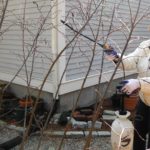
Winter moth caterpillars feasted on the leaves of this amalanchier last year. This March, it is getting a horticultural oil.
Horticultural Oil is Your Best Friend in March. One of the first lines of defense in the spring is a good spraying of horticultural oil before pests – such as the winter moth caterpillars – begin hatching. Left unmolested, winter moth and gypsy moth caterpillars will devour the leaves on trees and shrubs including your oaks, maples, apples, blueberries and others. Spray on days when the temperature is above 50° and will not drop below freezing that night. Horticultural oil can actually suffocate and kill the eggs before they hatch, with very little risk of danger to the plant or native wildlife. Remember, though, horticultural oil will only reduce the population, not eliminate it because many eggs were laid high up in trees where we cannot spray. Nevertheless, it is a worthwhile first step in pest control.
Time to trim Hydrangeas. While the ground is frozen, finish up your winter pruning. Remove the branches of hydrangeas that bloomed in late summer and fall as well as summer and fall flowering clematis. Can’t remember when your hydrangea bloomed? One hint is if dried flower heads still remain they probably bloomed late. This year, take photos and put them into a folder by month so you don’t have to guess next spring. You do not prune the native oak leaf hydrangea unless it is for size or has been damaged.
Indoor Plants. Not every day is good for outdoor gardening, but now is a good time to do some work indoors. Transplant houseplants now to prepare them for a spring growth spurt. Always use a clean pot. Scrub salt and dirt from old pots and rinse out new pots before using. Remember to never put a plant into a pot more than one size larger than its current pot. Otherwise it will disappoint you by spending more energy growing underground than up top. Prune dead or circling roots to encourage new ones to form. Always remove dead leaves, old flowers, and any salt that have built up around the stem of the plant or on top of the soil. And don’t forget to wash the leaves to remove dust from them. Finally water thoroughly but do not let the plant sit in the water that has drained through.
Last call, First call. Early March is your last opportunity to order seeds and clean tools before the season gets underway. If you’ve put off your seed order until now, you will find seed houses have sold out of some popular varieties. Tools that aren’t clean, sharp, and in good repair will make your end-of-winter cleanup and spring prep work harder. Now is also the best time to get annual maintenance done on lawn mowers and rototillers. Shops can do any work on your equipment in a few days. When the warm weather comes, the turnaround time can stretch to several weeks.
Clean up fallen branches. The two wind/rain/sleet/snow storms in mid- and late February left yards littered with downed branches and even trees. If you remove debris while the ground is still frozen, you’ll prevent leaving footprints that add to soil compaction later. Compacted soil lacks the oxygen to allow plant growth.
Pruning time, but stay away from spring blooming plants. While the ground is frozen, do go into your yard and remove any branches on trees and shrubs damaged by winter storms. You can safely prune most fruit trees and shrubs (blueberries, raspberries) now. Avoid pruning any spring-flowering trees and shrubs. They’ve already set their buds and all you will do is reduce the number flowers that will bloom.
Prune back and remove rose canes and vines that were left in place last fall. They need to go away so the new growth can emerge in late March and April. Do not be hasty in removing protective mulches or covers from roses, perennials, bulb beds and so forth. There’s no way to predict the date of the last snow or hard freeze, and those mulches are your best protection.
Plant dormant roses as soon as the ground can be worked. If you are thinking of planting new trees or shrubs this year, remember the earlier you can get them in, the more time they will have to establish their roots before the blistering heat of summer.
Pollinators are all in the news because we’ve been awakened to the drastic drop in numbers of everything from native bees to Monarch butterflies. Bees are being killed not by some single pesticide (products to kill insects) or herbicide (products to kill unwanted plants and weeds) but, rather, by the accumulation of chemicals that we put on our lawns, gardens and trees, and in our waterways. Since pollinators are responsible for one third of all the food you eat, cutting down on the use of lawn and chemicals is a vital first step.
An equally important step is planting food sources – pollen-rich plants for them to live on – while allowing a few weeds to survive too. Milkweed is the only plant that monarch butterfly young can eat as they grow from a caterpillars to butterflies. So, when you are planning your garden this year, make certain to include as many pollen-rich plants to feed your friends and even a few weeds to give them a start in life. We all need to eat, and having butterflies ornament our garden is a more than just a pleasure.
Think native. Finally, not all flowering plants provide useful pollen. Many plants imported to North America from other parts of the world produce pollen that our insects cannot use. Moreover, some of the new cultivars have had the pollen bred out of them. They have pretty flowers for us to look at, but they’re a sterile environment for insects. To be certain you are offering a good source of food, plant native some plants such as butterfly weed (a very pretty flower made prettier by its visitors), Echinacea (cone flower) and rudbeckia (black eyed susan). And don’t forget the bright red flowers like red salvia or bee balm (monarda) for the hummingbirds.
Pruning. While the ground is frozen, finish up your winter pruning. Remove the branches of hydrangeas that bloomed in late summer and fall as well as summer and fall flowering clematis.
Prune out broken or diseased tissue, crossing or rubbing branches and inward growing stems on all fruit trees, bushes and grape vines. Remove the old canes from June bearing raspberries and up to a third of old growth on blueberry bushes
Bring spring indoors. Force branches of witch hazel (which smell great) forsythia, quince, cornus mas, fruit trees and magnolia. Remember when you are cutting branches, you are actually pruning, so keep the plant’s shape in mind. Make a fresh cut and place the branches in 3 inches of warm water with a preservative. Change the water regularly to prevent the growth of bacteria which can inhibit blooming. When the buds open, bring the branches into a bright room and enjoy some early spring.
Once the snow has melted, clean up the debris from winter storms. Then get a soil test for each area of your yard—lawn, vegetable garden, flower garden—if you haven’t had one in the last three years (http://soiltest.umass.edu/). When the lawn has dried enough to allow you to walk on it without creating impressions in the soil, rake it to remove dead and matted grass. Thin or bare spots in the lawn can be ‘frost seeded’ by simply spreading seed over the area. The freeze and thaw cycle, or even a late snow, will ensure that the seed is worked into the lawn. Spring is not a good season for a complete lawn makeover. Weed seeds that are present will more quickly take advantage of the conditions you create for the grass.
And don’t be hasty in removing winter mulches from roses and tender perennials.
The vegetable garden. Do not start working soil too early before the winter moisture has dried. Soil is ready to be worked when it crumbles when lightly squeezed in your hand. If this winter ends and the snow now on the ground melts, you may be able to plant peas, spinach, many oriental greens and swiss chard at the end of March.
While snow covers the ground is the time to start seeds for this year’s garden. Under grow lights you can start onions, leeks, broccoli, and cauliflower now. For your flower garden, sow seeds of geraniums, petunias, snap dragons, begonia and coleus.
Wait until the end of March (or roughly 6-8 weeks before the last frost) to start tomatoes, peppers, eggplants and herbs such as parsley, sage, oregano—but not basil until the end of April.
Put aside the seeds of leafy crops like salad greens, kale, oriental greens and chard; the root crops like beets, carrots and turnips; and beans corn, peas and summer and winter squash—all of which are happier if they are not transplanted. Double check the seed packets to be certain that you are not planting seeds until the soil is warm enough for that variety to grow.
Take a break for the Flower Show. The spring we are all pining for will be on display for 5 days (March 12-16) at the Boston Flower and Garden Show. Exhibit one of your prize houseplants and see how great it looks with a blue ribbon attached. Listen to the speakers, talk to the exhibitors, inhale the scent of mulch and growing plants. Then go home charged up for another season of gardening—as soon as the snow melts!
Repot Houseplants Now. Days, even indoors, are getting longer and houseplants feel that too. Now is a good time to report them, removing any soil with salt build-up (the crusty stuff on top) and some of the old soil around the roots. The pot should be only 1-2 inches larger than the current pot, clean and filled with an appropriate soil mix. Most houseplants are happy with commercial or homemade potting mixes, but I add sand to the mix when transplanting succulents or cacti and small bark chunks to orchid pots. Once securely in the new home, water then with a diluted fertilizer solution to help them settle in and get off to a growing start.
Count before you Sow. If you have your vegetable or flower seeds and are anxious to get going, check the packages or online instructions for the best time to start. It is generally not safe in Southern New England to assume the last frost date will have passed before June 1. Hot weather crops want warm soil (at least 70 degrees) and warm air temperatures. Last year, the Mass Hort Garden-to-Table vegetable garden lost melon seedlings when the temperature dropped into the 50’s for a couple of nights in early June. It makes no sense to start tomatoes in early March and then keep them indoors for three months before they can safely go in the ground. Wait until April to start most vegetables and flowers.
Squeeze before you Sow. Traditionally pea planting time in New England is St. Patrick’s Day. I think it may be delayed this year. Our three weekends of snow have left the soil covered with a lovely white blanket which, when it melts, will leave the soil too wet to plant immediately. The home gardener’s test is to take a small handful of soil and squeeze. If it holds together as a wet clump, or heavens forbid, water squeezes out, you need to wait and hope for sunny dry days. Seeds put into cold wet soil will rot. Soil ready to plant should crumble apart like chocolate cake. Working wet soil with tiller or spade will destroy its structure. But as soon as it is ready, plant peas and turnips, onion sets and spinach, salsify, cabbage and lettuce.
Strawberries. Late March is the time to set out your strawberry plants. If you didn’t prepare the bed last fall, do so as soon as the soil can be worked. Or, start a new raised bed by creating a bed 8 (or more) inches deep with a mixture of good soil and aged manure or compost. The soil should be tested and have a ph of 6 or less, as strawberries do best in soil that is slightly acid.
Make the holes 12 inches apart and about 8 inches deep, then create a small mound of soil in the hole. Fan the roots over the mound so they are spread throughout the hole. Be certain the crown of the strawberry is placed so that it half under the level of the bed and half above when the soil has been firmed in place. This way it will not be likely to rot or smother. Water thoroughly and mulch. Plant rows three feet apart. Heat-treated shredded straw makes an excellent weed free mulch that also keeps developing berries clean.
Roses. It is too early to remove the protective mulch you put around your roses last fall but, as soon as the soil is ready to be worked, it is the right time to begin planting dormant roses. Dormant or bare-root roses come with the roots exposed and need to get into the ground early. Dig the hole wide enough to spread the roots out, deep enough to plant the bud union (the bump where the hybrid variety you want is grafted onto a hardier rootstock) is two inches below the level of the bed. Creating a soil mound and draping the roots over it will allow you to check the height as you work. Half-fill the hole with soil, patting it down with your hands. Add water and, when it has settled, continue filling the hole. Firm it again, add more water and make certain the bud union is still 2 inches below grade. Then create a saucer using soil to form a lip just outside the root zone. Now you can water your new rose without the water or soil running off. But don’t feed the rose until the roots have had some time to establish themselves.
Get Ready. Send your mower and tiller in for tune-ups now if you didn’t in the fall. Finish sharpening your pruning tools, we will have a lot of clean-up including pruning to do after the snow has melted. And look for new ideas, plants and products at the Boston Flower & Garden Show.
The ground is still frozen but planning your garden should be well underway. Your flower and vegetable seed order should be arriving soon. Check the packet for advice on when to start seeds. Starting them too early often leads to leggy or weak seedlings from having spent too long waiting indoors for warm weather to arrive. Use only sterile soil mixes to prevent damping off of seedlings.
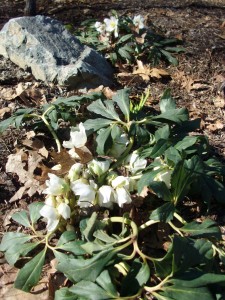 Take a walk around your yard (staying off frozen ground) and enjoy the earliest flowers. Witch Hazels (Hamamelis) are in bloom and cornelian dogwood (Cornus mas) are close behind. As snow cover gives way look for hellebore blooms to put in an appearance along with the early bulbs such as snowdrops, Siberian squills and crocus.
Take a walk around your yard (staying off frozen ground) and enjoy the earliest flowers. Witch Hazels (Hamamelis) are in bloom and cornelian dogwood (Cornus mas) are close behind. As snow cover gives way look for hellebore blooms to put in an appearance along with the early bulbs such as snowdrops, Siberian squills and crocus.
If you had a lovely blizzard of moths last November or December around your outdoor lights, your plants will soon to be under attack. That blizzard was winter moths — an unwanted invader of our land — who between mid-March and late April will hatch from eggs laid in the bark and crawl into the leaf buds of many of our trees. Once there, safe from any pesticides we may spray on them, they will chew away at the new leaves. They seem to particularly favor oak, maples and fruit trees but will eat almost anything they encounter including roses and perennials. After the leaf buds open, the mature caterpillars will spin threads and be spread further by the wind. Appropriately timed sprayings can reduce their number and the damage to your plants. Contact a state-certified arborist to spray your trees particularly if they have been weakened by infestations in the past years. For more information about treatment for winter moths, see this article.
Your houseplants should have awakened from their winter slumber. If you haven’t already, begin fertilizing to feed the new growth. Don’t forget to keep the humidity up with misting or pebble trays—our homes remain very dry as long as the heating systems are on.
Your best plants deserve to be shown at the Boston Flower and Garden Show. There’s a category for almost every plant in your home. Take a look at the Amateur Horticulture entry list under Blooms! on MassHort’s website and start primping. A careful cleanup, from washing leaves with warm water to removing imperfect leaves and errant dirt and debris, is the path to a shiny ribbon. Entry day is March 22, 12 noon to 8 p.m. at the Seaport World Trade Center.
